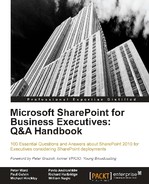A: Good question; unfortunately only you can answer that. SharePoint topologies can be very simple (a single-server intranet) or can become incredibly complex (a global, multi-lingual extranet with cross-farm services). Your business should understand the requirements and goals clearly and very early on in the planning phases, before financially committing yourself to any particular design. Ask yourself the following questions:
- Who are my target end users?
- What type of content am I exposing?
- What is my budget?
- What will it cost me to plan ahead and do the work now, rather than risk re-architecting later?
- Would this topology be more optimal on-premise, hosted, or in the cloud?
A SharePoint 2010 intranet environment is the classic web application — a private network that can only be physically accessed within your organization. This is the cheapest and simplest topology that an organization would choose. It is simple in terms of licensing, configuration, overhead, and manageability. Besides internal employees, it is also suitable for firms that have small numbers of external users who can be accounted for through the current licensing model, and serviced via existing access methods (such as via VPN). This topology should not require a complicated networking infrastructure, nor should you have to invest in additional supporting technologies to provide immediate value to end users.
An extranet environment is a private network that is securely extended to share part of an organization's information or processes with external users such as partners, vendors, and clients. Extranets are used to share information and to offer alternatives for employees to work from remote locations. However, properly setting up an extranet requires outlining specific business requirements and giving important consideration to the following items:
- Networking and hardware infrastructure: Your requirements will dictate the changes and additions to your IT infrastructure, so be prepared to invest in hardware, software, and networking equipment.
- Disparate identity management systems and access: External users will likely be members of independent identity stores. This will impact how accounts will be managed and how other systems will interface with your environment.
- Security and isolation: Content will need to be isolated and segmented, based on the access rights of external users and their parent organizations. This will require significant planning and oversight, especially if your organization is bound by regulatory compliance.
Many formal SharePoint 2010 extranet topologies exist, but they are outside the scope of this book. Just to give you an idea, these include configurations such as the Edge Firewall, back-to-back perimeter, back-to-back with cross-farm services, and Split back-to-back. You can find more information on these and other topologies in the Digging deeper section at the end of this chapter.
Many organizations have built their public Internet presence using SharePoint 2010. If you are thinking about going down this road, note the following considerations:
- Licensing: As mentioned earlier, specific licenses are required for this type of setup
- Access: Determine the purpose of your site and access requirements, external authenticated users versus anonymous users
- Functionality: There are specific caveats for anonymous users when it comes to workflows, forms, and other features
Some sample Fortune 500 companies that have public sites powered by SharePoint 2010 include Kraft Foods, HESS, Bristol-Meyers Squibb, Phillip Morris International, and DELL (financial services).
